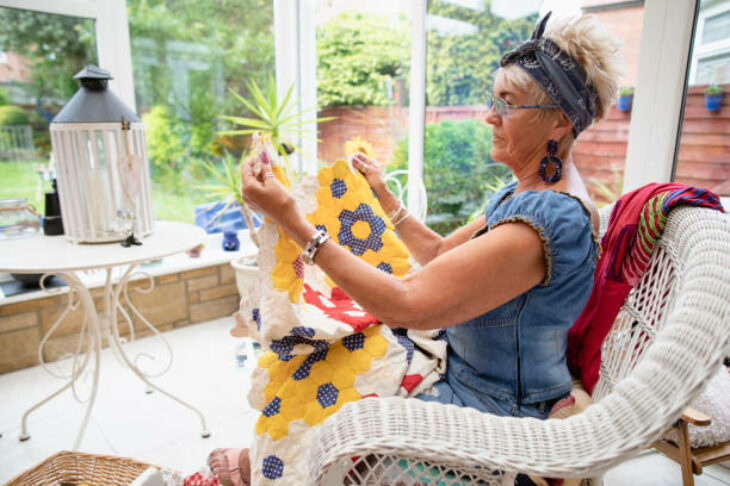Quilting dates back thousands of years as both a utilitarian craft to provide warmth and protection and an art form to showcase decorative stitching and designs. Patterns and fabrics can represent family history, tell stories, or highlight important cultural events. Quilting has also been a social event over the centuries as groups of women came together to complete a quilt as a community.
What is Quilting?
The term quilting refers to the technique of attaching three layers together (usually a backing, padding, and front fabric) to make a finished fabric piece, whether for a bed, wall hanging, or clothing. The decorative stitching pattern visible on the front that attaches everything gives quilts their distinctive look. Three main quilting styles transcend the centuries—patchwork, applique, and whole-cloth. For beginning quilters, a patchwork style is easiest and creates an iconic look that can highlight memorable family events, showcase sentimental fabrics, or display your creativity.
Basic Supplies
- A sewing machine: Quilting by hand can be a meditative art form for some, but if you’re working on a big piece or don’t have the time or dexterity to do everything by hand, invest in a sewing machine.
- Fabric shears: Sharp scissors you only use for fabric are critical to getting the best cuts. Even better, use a rotary cutter to take the pressure off your joints while cutting.
- Cutting mat: Investing in a good mat makes cutting and measuring more straightforward.
- Thread: Choose matching or contrasting threads as you desire to highlight your pattern.
- Batting: The stuffing in the middle will provide weight and warmth.
- Fabric: The fabric is the fun part! Use new pieces, scraps from old projects, or special family cloth. You’ll also need a large, solid piece for the backing.

Local Resources
If quilting is a new hobby or you’re reviving old quilting projects you may be in need of new tools or inspiration from a variety of fabrics. Long Beach is home to many quilting project resources, here are just a few –
- LA Finch Fabrics 3928 North Virginia Rd, Long Beach
- Chic Fabric Remnants 1704 East Anaheim St, Long Beach (562) 591-3572
- Sew Vac Ltd 1762 Clark Ave, Long Beach (562) 498-6684
- Fabric Barn Inc 3111 E Anaheim St, Long Beach (562) 375-7235
Choosing a Pattern
Choosing a simple pattern that doesn’t require too much cutting or matching is best for beginners. You can browse free quilting patterns here or create your own! Make sure to draw your pattern on grid paper so that you can easily measure the size of each piece relative to your project. With your pattern nailed down, it’s time to measure and plan so you can buy the fabric. Make sure to leave a seam allowance on every piece (where you’ll stitch it together) and buy more fabric than you think you’ll need to make up for mistakes. For example, pattern calculations, use this tutorial as a guide.
Prep Work
Much of the labor that goes into quilting comes before anything looks like a quilt! Washing and ironing your fabric is an essential first step. You’ll save yourself a headache if your fabric is already pre-shrunk. Next, you’ll want to spend time accurately cutting your shapes for the front fabric—getting straight cuts is crucial for steps down the line, so don’t skimp on this detail work. Good cutting tips are here, especially as you get more advanced.
Sewing
This step, called “piecing,” is where your hard work starts to pay off. You’ll pin the fabric shapes together to form sections of the finished quilt pattern, then sew them together along your seam allowances. It’s easiest to piece together in a few steps, making small shapes into bigger squares, then sewing those together until your front fabric is complete.
Assembling
Also called “basting,” this assembly stage is tedious but must be done accurately. You’ll need an ample space to lay your backing fabric wrong side up, then top it with the batting of your choice. Finally, lay your front fabric on top to make a three-layer sandwich. Using basting pins or safety pins, connect all three layers securely every three or four inches—you don’t want anything to move around! If pinning is tricky, try a basting spray instead.
Quilting!
To keep your batting from moving around and bunching up over time, you’ll use decorative quilting stitches running through the entire piece to hold everything in place. Stitching along the seams between your front pieces is a straightforward way to stay on track and get full coverage. For slightly more decoration, try stitching along the seams and adding perpendicular, diagonal, and parallel lines. “Free motion quilting” is an advanced technique that allows quilters to move the fabric in every direction to create the swirls and loops that are so lovely to see. No matter your quilting choice, make sure to add enough stitches to keep everything in place for years to come.
The best way to learn to quilt is to practice, so get started on a project today!
The Active Aging Series is brought to you by our partner, Cambrian Homecare. Cambrian Homecare has been assisting individuals to stay independent in their homes for 25 years. Flexible experience you can trust, when the best place is still at home.

